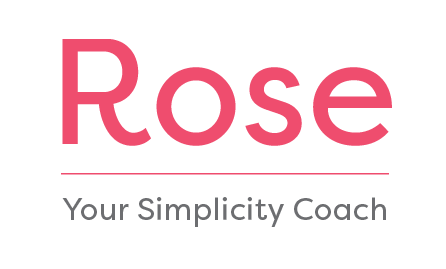*This is a guest post from Julia Ubbenga of Rich in What Matters.
In a recent conversation with a good friend, I recognized myself three years ago.
“I can’t stand the mess in our home,” she expressed. Following her toddler around the playground with her, I listened.
“We can’t have people over like we’d hoped to when we bought our home. There’s just too much stuff.
My husband says I pay too much attention to the mess, but I can’t help it. It bothers me—a lot.”
My heart went out to her—I’d been in that exact spot. Overwhelmed, frustrated, and ready to channel all those feelings toward a significant change.
She told me about a decluttering course she was considering. One that promised to deliver quick results and teach systems to maintain an uncluttered home. Then she told me she felt bad having to buy a course for guidance. Shouldn’t she already know how to declutter her home?
The truth is, no.
Decluttering tools and maintenance systems aren’t common knowledge. Why? Because they’re not the American norm. Minimalism, in fact, is countercultural.
The rise of consumerism and America’s “bigger, better, more” mentality has left us with a clutter problem. Consider these statistics.
- 54% of Americans are overwhelmed by the amount of clutter they have, but 78% have no idea what to do with it. (source)
- Americans spend an average total of 2.5 days a year looking for misplaced stuff. (source)
- Women’s stress levels are directly proportional to the amount of stuff in their homes.(source)
- Getting rid of clutter eliminates 40% of housework in the average home. (source)
For many of us, our clutter is a problem that needs to be addressed. But unless you grew up in a minimalist home, why would you expect yourself to know how to journey into minimalism?
When I committed to going minimalist three years ago, I signed up for three different courses over the span of six months. The courses didn’t do the work for me—only I could remove the unneeded and unloved stuff from our home—but they guided me and inspired me to keep going.
While there is no “right way” to jump into minimalism, certain tools will help you get the job done more quickly and efficiently.
Over the past three years of living a minimalist lifestyle, I’ve found nine minimalist tools that have been the most helpful in decluttering our life. Some I’ve created and some I’ve gleaned from other minimalist thought leaders. Six of these tools are for decluttering tangible stuff and three are for decluttering intangible stuff (minimalism is about letting go of more than just the physical things that no longer serve you).
Here are nine minimalist tools that will help you declutter your life today:
1. Power of Half – Decluttering the kitchen
Most kitchens contain much more than necessary. Unless you host people frequently in your home, you really only need one or two plates, bowls and utensils per person. And you don’t need duplicate kitchen gadgets (like multiple spatulas).
Experiment with less by tapping into the power of half. Grab a box and place half of the contents of your kitchen in it. Then store the box away for three months and see if you need to retrieve anything from it. After that time, donate what you no longer need so some else can use it. We did this about a year ago, and I was finally able to implement a system for keeping our sink clear of dirty dishes once our kitchen contained less stuff.
Read more about decluttering your kitchen pantry here.
2. Box and Rotate – Decluttering kids’ toys
The United States now contains about 3% of the world’s children but 40% of the world’s toys. This discrepancy calls for decluttering. My favorite tool for decluttering kids’ toys is called the Box and Rotate method. Pile all the toys in your home in one place. Find a large plastic storage tote. Put your kid’s favorite toys in that tote (If your child is seven or older, have him/her help you). Box up the rest of the toys and put them out of sight.
Now, take five to 10 toys out of the favorites tote (only take out as many toys as your child can tidy up independently). Store the favorites tote out of sight. Each week or so, rotate new toys out of this tote. After three months, if your child hasn’t asked for any of the toys in the “unfavorites boxes,” donate them so another child can use them.
Read more about decluttering kids’ toys here.
3. Recall Task – Decluttering kids’ books
My favorite tool for decluttering kids’ books is the Recall Task. Pile all your kids’ books together. Take a pen and paper or use the notes app on your phone, then go somewhere away from your pile of kids’ books.
Then brainstorm. Write down all the books that you know your family loves—those that your kids beg you to read to them, those that you love reading to your kids. List them out. Then, take your list and go back to your pile of books. Sort out only the books that are on your list. Those are the books you want to keep in your home because those are the ones that you know your family uses and loves.
4. Sunday basket – Decluttering paper
Author Lisa Woodruff recommends decluttering paper in your home with a Sunday basket system. Take a basket and make that your designated place for any active papers around your home—bills, receipts, coupons, kid’s artwork—put it all in that basket.
Then, find a time on the weekend when you can sit down with the basket and go through the paper, addressing it as needed. File it away in whatever system works best for you. Shred it. Recycle it. This way you always know where your paper is and you won’t have paper piles forming throughout your home.
Read more about decluttering paper in your home here.
5. Suitcase Experiment – Decluttering kids’ clothes
My favorite tool for decluttering kids’ clothes is the Suitcase Experiment. Take a suitcase and pretend that you are going on vacation somewhere for about a week (your destination is somewhere you know you can do laundry). Pack as you would for your kids. Box up whatever clothes remain in the drawers and store the box away for a couple months. Put the contents of the suitcase back in the now-empty drawers.
After a couple months, if you haven’t had to pull anything from that box in storage, then donate it so other kids can use those clothes. (The first thing I did when we committed to living a minimalist lifestyle was declutter kids’ clothes using this tool. It immediately cut my laundry load in half.)
6. Spontaneous combustion question – Decluttering sentimental items
The Minimalists recommend using the spontaneous combustion question to declutter sentimental items. To do this, take a sentimental item in your hand and ask yourself, “How would I feel if this item spontaneously combusted?”
Would you feel relieved? Then let that item go. Would you feel good, but a little bit of guilt? Then take a picture of the item and then let it go. Would you feel devastated? Then that’s an item that you definitely want to keep.
Read more about decluttering sentimental items here.
7. Rule of Three – Decluttering Comparison
My favorite tool for decluttering comparison is the Rule of Three. The premise is this: for every one of your thoughts that is comparative in nature, replace it with three thoughts of gratitude.
For example, if you are on Pinterest and see a beautiful kitchen, you may begin wishing you had a kitchen like that. You may start feeling bad about yourself because you don’t. Catch that thought. Don’t judge it—just observe it. Then replace it with three things you’re grateful for. You could think: “I’m thankful I have a roof over my head. I’m thankful I have a family in this home who loves me. I’m thankful that I have food in this kitchen to feed my family.” This type of thinking changes your brain chemistry. And it helps you let go of any comparison in your life.
8. ANT Catching – Decluttering self-talk
We have up to 50,000 self-talk thoughts a day and 80% of them are negative. My favorite tool for decluttering them is called “ANT catching.” ANT is an acronym coined by Dr. Daniel Amen, which stands for “automatic negative thoughts.” They need to be caught and let go of by being replaced with a truth statement.
An example of an ANT is labeling. Say you raise your voice at your kids and automatically you think “I’m a bad mom.” That’s not true—catch that thought. Replace it with a truth statement that might sound like this: “That situation really tested my patience. I’m human, I make mistakes. I’m showing up and doing my best.”
Read more about how to be kinder to yourself here.
9. Inward Listening – Decluttering “caring what others think”
We’re all wired to care what others think to some extent. In ancient times, not being part of the tribe jeopardized one’s very existence.
The best tool I’ve found to help let go of caring about what others think is called Inward Listening. Find a quiet place, sit and listen. To let go of caring what others think, you need to develop true confidence in who you are.
In my experience, as a Christian, the best way to develop true confidence is by getting to know the one who made you. This means conversing with him regularly—about why he made you a certain way and how he wants you to accept and use the gifts you’ve been given. Once you’ve developed confidence rooted in true self-awareness and know what you stand for, letting go of what others think becomes much easier.
Read more about letting go of caring what others think here.
Minimalist author Courtney Carver said, “The realization that you need way less than you think to be happy will change your life in the most amazing ways.”
If you’re ready to declutter your home (and your heart) and looking for quick, sustainable results, then I recommend trying out the tools above. These tools have worked for us and their results have been life-changing.
They’ve transformed the feel of our home from being defined by stress and overwhelm to being grounded in calm and order. They’ve allowed us to actually use our home as living space, not storage space. And most importantly, they’ve freed our time and energy to live our lives focused on what matters most.
About Julia: Julia Ubbenga is a freelance journalist whose teachings on minimalism, simplicity, and intentional living have reached thousands of people worldwide through her blog www.richinwhatmatters.com. Julia practices what she preaches in her Kansas City home with her husband, two lively young daughters, and 18-month-old son. You can connect with her on Instagram.









